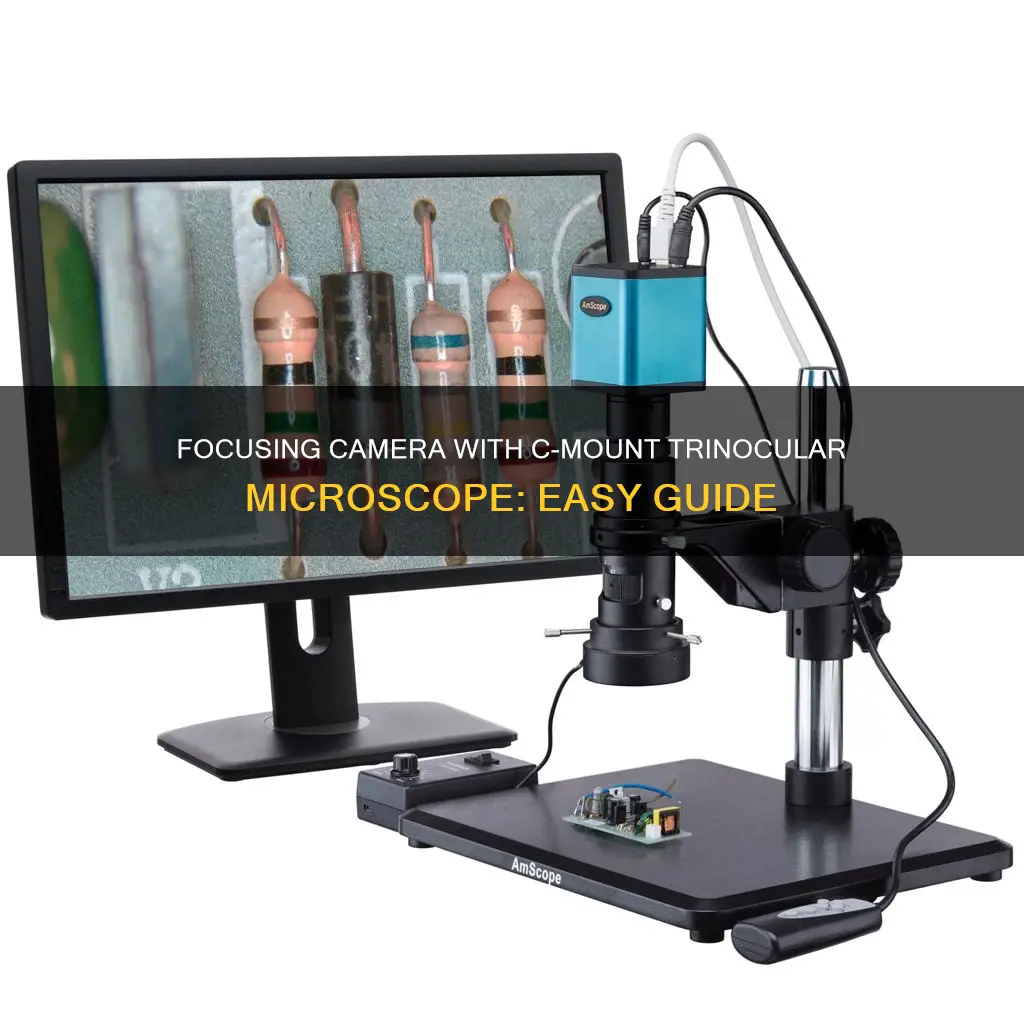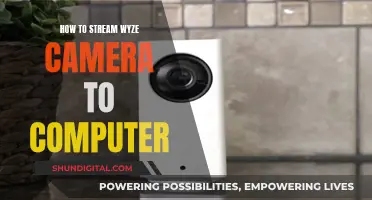
To focus a camera with a C-mount trinocular microscope, you need to attach the camera to the microscope using a C-mount adapter. The C-mount is the industry standard for connecting digital imaging devices to microscopes. The C-mount adapter connects the camera to the trinocular port of the microscope. The correct adapter will depend on the make and model of the microscope and the camera. The C-mount adapter will have a standard 1 (25mm) diameter thread, with 32 threads per inch. The microscope-specific end connects to the trinocular port, while the other end connects to the camera.
| Characteristics | Values |
|---|---|
| C-Mount adapter function | Allows you to connect a microscope camera to the trinocular port of the microscope |
| C-Mount adapter specificity | Microscope-specific; designed for the brand of microscope to keep the camera in focus while the eyepieces are in focus |
| C-Mount adapter diameter | 1" (25mm) with 32 threads per inch |
| C-Mount adapter optics | Supplied with or without optics to match the adapter with the size of the sensor within the digital camera to maximise the field of view |
| C-Mount adapter focus | Most modern adapters are focusable, allowing you to adjust the focus so that the image from the camera is also in focus |
What You'll Learn

C-mount adapters are microscope-specific
While generic c-mount adapters can be used in some cases, they may not be able to achieve simultaneous parfocalled images with the eyepieces. The c-mount adapter's function is to ensure the camera captures a similar magnified image as what is observed through the eyepieces. This is achieved through a reduction lens within the adapter, which allows for different magnifications depending on the camera's chip size.
The c-mount adapter also plays a crucial role in matching the camera sensor with the microscope's optics. Cameras have rectangular sensors, while microscope optics are circular, leading to a discrepancy in the field of view. C-mount adapters, with or without optics, aim to maximise the field of view by matching the adapter with the camera sensor size. Opting for a mount that "over de-magnifies" can result in vignetting, causing shading and distortion in the image's corners.
Furthermore, c-mount adapters are available with focus adjustments, allowing users to fine-tune the focus of the camera independently from the microscope's focus. This feature ensures that the camera captures sharp and clear images, even when the microscope's focus may be slightly off.
Activating Camera Mode in Blender: A Step-by-Step Guide
You may want to see also

Cameras with reduction optics vs cameras without reduction optics
Cameras with reduction optics are used to reduce the size of the image produced by the microscope objective to better match the small sensor size of the digital camera. The reduction lens produces a real image on the camera sensor. Without the reduction lens, the image would be magnified too much. The reduction lens also results in a brighter image.
Cameras without reduction optics can be connected to a microscope via a dedicated photo tube on a trinocular head, or can be connected to one of the microscope’s eyepieces. The image produced by the microscope objective can be directly picked up by the sensor of a camera, without an eyepiece or other intermediate optics. The objective of a microscope produces a relatively large image, compared to the small sensor of many cameras. Unless the sensor is large, there may be quite a bit of empty magnification and the brightness of the image is low.
Charging the Fujifilm FinePix 10 X Wide: A Step-by-Step Guide
You may want to see also

Using a mobile phone as a camera
However, it is important to note that setting up and adjusting the adapter can be tedious. The mobile phone camera needs to be perfectly centred, and the distance from the camera to the eyepiece must be adjusted precisely. This process can be time-consuming and may require some trial and error. To streamline the process, it is recommended to purchase an extra eyepiece and permanently connect the adapter to it. When ready to capture images, simply remove the regular eyepiece from the microscope and insert the pre-adjusted eyepiece-adapter combination.
Another challenge when using a mobile phone camera is the wide field of view, resulting in a circular image similar to the view through the microscope eyepieces. This can lead to two issues: firstly, not all pixels of the camera are utilised, and cropping or digital zoom may be necessary to remove the black border. Secondly, unless high-quality plan objectives are used, the edges of the image may appear blurry while the centre remains crisp. To address this, additional cropping or image editing may be required.
Despite these challenges, using a mobile phone as a camera for a trinocular microscope offers several benefits. It is a cost-effective solution, eliminating the need for a separate microscope camera. It also allows for easy sharing of images and videos, enabling users to seek help from the online microscopy community. Additionally, the live-viewing feature on smartphone screens can be advantageous for extended observation periods.
In conclusion, using a mobile phone as a camera for a trinocular microscope can be a viable option, especially for those seeking a budget-friendly solution. While it may require some initial setup and adjustments, the convenience of capturing images and videos directly through the microscope eyepieces, along with the ability to share and seek input from others, makes it a popular choice for many.
Finding the Synchronize Button in Camera Raw: A Quick Guide
You may want to see also

Using a compact camera with a zoom lens
This method allows you to take pictures and HD videos. However, setting up and aligning the camera can be time-consuming and inconvenient. Additionally, if the system is not properly set up, you may experience vignetting, which is when the image is too small and appears in a circle.
Lorex Cameras: Low-Battery Alerts and Notifications Explained
You may want to see also

Using a DSLR camera
Equipment
Firstly, ensure you have the right equipment. You will need a microscope with a trinocular head (an extra eyepiece designed for attaching cameras). Although it is technically possible to connect a DSLR to a regular microscope eyepiece, the weight of the camera can destabilise the microscope. Therefore, it is recommended to use a microscope with a trinocular head.
You will also need a DSLR camera and a DSLR Camera Microscope Adaptor. It is important to ensure that your adaptor is compatible with your specific brand of microscope and camera. If your camera and microscope are from the same brand, you may only need one adaptor. However, if they are from different brands, you may need an additional T2 ring adaptor to connect your DSLR adaptor to your camera.
Setting Up
Once you have your equipment, follow these steps:
- Disconnect the regular camera lens from your DSLR camera. Usually, there is a release button on the side of the camera; press it and gently twist the lens (often clockwise) to detach it.
- Attach your T-ring adapter to your DSLR adapter, if you need one. T2 rings simply screw onto the top of the DSLR adapter.
- Attach your DSLR adapter to your camera. Line up the red or white dot on the outside ring of your adapter (or T-ring) with the red or white dot on the connection area of your DSLR camera. Then, gently rotate the adapter (usually anti-clockwise) until it snaps into place.
- Insert the other end of the adapter into the vertical phototube/camera mount/trinocular port of your microscope. The adapter with the camera attached will sit in the trinocular port. Some adapters or microscopes may have 'locking screws' to secure the camera in place.
- If you are using adjustable or universal DSLR adapters, you might need to attach an additional adapter to the microscope end of your DSLR adapter or directly into the phototube. This ensures that the DSLR adapter fits correctly.
- Some adapters or trinocular ports are extendable, allowing you to adjust the length of the optical system to suit your needs.
Now, your DSLR camera should be successfully connected to your trinocular microscope, and you can start capturing high-quality images!
Charging Sanyo VPC Camera: A Step-by-Step Guide
You may want to see also
Frequently asked questions
C-Mount is the industry standard for connecting digital imaging devices to microscopes. It is a 1" diameter threaded port with a specific focal depth to the camera sensor. The port is female on the camera side and male on the microscope attachment.
A C-Mount adapter connects a microscope camera to the trinocular port of the microscope. The adapter has a standard 1" (25mm) diameter thread and is microscope-specific, meaning it is designed for the brand of microscope to keep the camera in focus while the eyepieces are in focus.
You must use a C-Mount adapter that was made specifically for your microscope brand. For example, if you are using a Zeiss microscope, you will need the corresponding Zeiss C-mount adapter.
Most modern C-mount adapters are focusable. This means you can first focus your microscope and then adjust the focus of the C-mount so that the image from the camera is also in focus.







